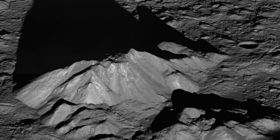A rocky planet weighing 17 times as much as Earth has been found, surprising astronomers who expected it to be a big ball of gas.
Scientists dubbed the planet a “mega-Earth” because it’s much larger than previously discovered rocky celestial bodies.
The planet, sighted by the U.S. National Aeronautics and Space Administration’s Kepler spacecraft, is located 560 light years from Earth and circles a Sun-like star every 45 days, The finding was reported yesterday at the American Astronomical Society meeting in Boston.
Scientists have theorized that a planet that big, formed when heavy elements were scarce in the early days of the universe, couldn’t have formed as a solid. They expected to find that the planet, called Kepler-10c, was a gas giant like Jupiter, made up primarily of hydrogen. Instead, when they measured its density with special instruments, they found it weighed more than Earth.
“Finding Kepler-10c tells us that rocky planets could form much earlier than we thought,” said Dimitar Sasselov, director of the Origins of Life Initiative at Harvard University, in a statement. “And if you can make rocks, you can make life.”
The new planet is in a system about 11 billion years old, forming less than 3 billion years after the Big Bang, according to the report today. The Earth is about 4.54 billion years old.






Leave a reply